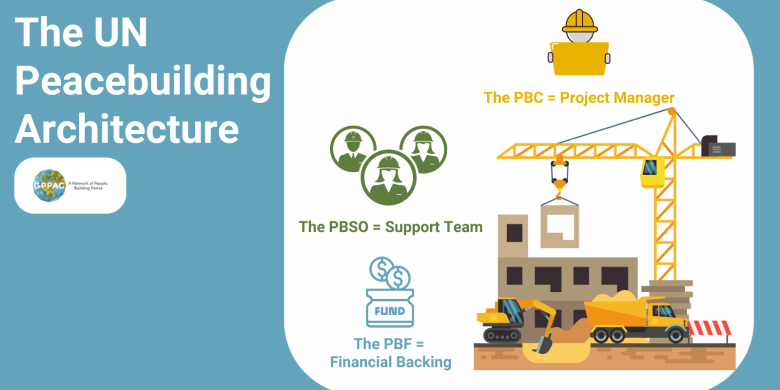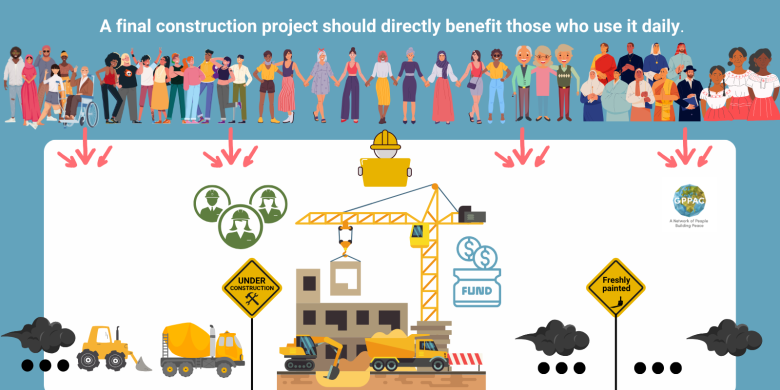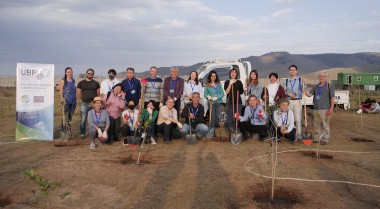
The UN Peacebuilding Architecture Review: What is it, and why does it matter for local peacebuilders?
Join us as we take you on a trip from a bustling construction site in a local community to the hushed conference rooms of global policymaking at the United Nations. Along the way, we'll help you understand the UN Peacebuilding Architecture Review and why it matters for local peacebuilders. Despite its reputation for complexity, we're here to simplify the journey and reveal why the Peacebuilding Architecture Review offers local peacebuilders a chance to influence global policies that lead to concrete changes in their communities.
The UN Peacebuilding Architecture
The UN Peacebuilding Architecture aims to support governments and their peoples as they seek to “prevent the outbreak, escalation, continuation, and recurrence of conflict, address root causes, ensure national reconciliation, and move towards recovery, reconstruction, and development” (S/RES/2282, PP8).
The Peacebuilding Commission (PBC), which consists of Member States; the Secretary-General’s Peacebuilding Fund (PBF), and the Peacebuilding Support Office (PBSO) manage the UN Peacebuilding Architecture.
It is easy to understand how these entities work together using a construction site analogy:
- You can imagine the PBC acting as the project manager. It oversees the entire construction process, coordinating with different teams and stakeholders to ensure everything runs smoothly.
- The PBF provides financial backing for the construction project. It provides the necessary funding to kickstart and sustain efforts, just as financial resources are essential for purchasing materials, hiring workers, and covering other expenses in a construction project.
- The PBSO functions as the support team. It provides crucial assistance, helping to organise resources, gather information, and keep communication flowing between different parties involved. It also advises on the most effective ways to allocate resources and prioritise tasks.

Why does the UN Peacebuilding Architecture need local actors?
Imagine one day, an international construction company suddenly arrives in your local community. Big bulldozers and excavators roll in. A team, with a project manager, sets up shop in a container, and they get to work for a little while.
Of course, you, being a local, know that the international construction company risks doing more harm than good if they do not understand what kind of construction is truly needed in your community. Therefore, it is crucial that the international construction company has the right tools, mechanisms, and processes in place to ensure the construction's stability and relevance to its community.

The UN Peacebuilding Architecture Review Process
Just as every construction site receives periodic inspections to ensure the project is on track and meeting standards, the United Nations Peacebuilding Architecture undergoes similar assessments every five years to evaluate its effectiveness and impact - known as the Peacebuilding Architecture Review (PBAR). This is a moment for local peacebuilders to ensure the UN has the right tools, mechanisms and processes to make a lasting difference at the community level.
In 2015, the UN Peacebuilding Architecture Review (the 2015 PBAR) resulted in coining the term 'sustaining peace', expanding the global understanding of what peacebuilding means across the conflict cycle through the 2016 dual General Assembly-Security Council Resolution (A/RES/70/262-S/RES/2282). The 2015 PBAR further led to the development of the 2018 Report of the UN Secretary-General (S/2018/43), which identified four focus areas and concrete commitments to strengthen the UN's ability to sustain peace across the conflict cycle: operational support and policy coherence, UN leadership, partnerships for peacebuilding, and financing for peacebuilding.
Five years later, the 2020 PBAR assessed the implementation of existing work of the UN system across the four key pillars outlined in the 2018 Report of the Secretary-General on Peacebuilding and Sustaining Peace, mandating the 2025 PBAR and requesting a detailed 2024 Report of the Secretary-General on peacebuilding and sustaining peace.
In 2025, the PBAR will take stock of the United Nations peacebuilding and sustaining peace efforts once again, focusing on the implementation and impact of the UN’s action on peacebuilding and sustaining peace at the field level.
This will happen through diverse tracks.
- The detailed 2024 report of the Secretary-General on peacebuilding and sustaining peace is due in 2024. Civil society is invited to provide written submissions by October 2024.
- The Peacebuilding Commission will convene meetings throughout 2025, with a chair's summary as an outcome document. Civil society will participate in some of these discussions as relevant.
- The eminent persons panel will be appointed to participate in consultations and meetings organised for the 2025 PBAR. The Panel will submit a letter to the Secretary-General and Member States containing their reflections on the implementation of the resolutions on the peacebuilding architecture. Civil society can invite eminent persons to their 2025 PBAR meetings and consultations.
- Member States and UN entities are encouraged to engage with relevant think tanks, policy and academic institutions and regional organisations to host inclusive thematic and regional consultations. Civil society can work with Member States to organise these consultations.
These tracks will result in a new resolution on peacebuilding and sustaining peace developed through an intergovernmental consultative process.
Why does this global process matter for local peacebuilders? Let's recap!
The Peacebuilding Architecture Review matters for local peacebuilders for 3 reasons:
- Global policy changes can lead to concrete changes at the local level. For instance, without the adoption of UNSCR 1325 on Women, Peace and Security by the UN Security Council in 2000, National Action Plans would not have been developed to drive national action on supporting women in peace and security, especially financially.
- It is a moment to expand your knowledge and increase your skills. The GPPAC network is a great space for hands-on peer-to-peer learning and strategic advice, sharing tools and resources to support your engagement in the global space! Local peacebuilders can improve their understanding of the system and develop strategies for follow-up engagement with relevant actors through the GPPAC network
- It gives access to people and opportunities. For example, the engagement of GPPAC members in the 2020 Peacebuilding Architecture Review led to the establishment of the Pacific Women Mediators Network. This initiative emerged from a thematic regional consultation on Gender, Climate, and Sustaining Peace in the Pacific, showcasing the concrete outcomes of participation in the PBAR process.
To ensure that the international construction company leaves a positive impact on the lives of people in the community, local peacebuilders’ support is required in the construction process. Their insight and expertise ensure that the construction project aligns with the community's needs, building a stable foundation. Similarly, active engagement in the UN Peacebuilding Architecture Review empowers local actors to advocate for policies that truly address local challenges and promote sustainable peace.


